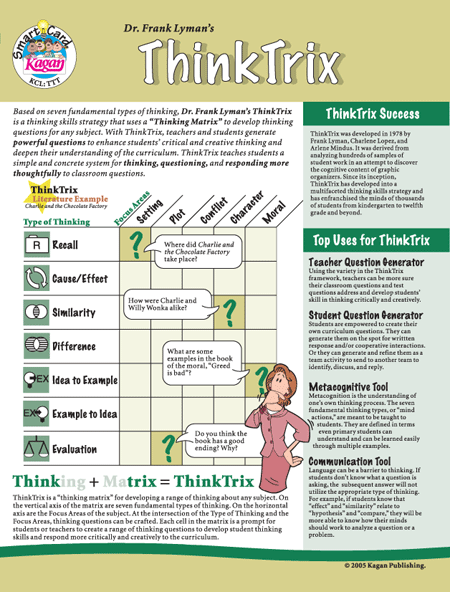
ThinkTrix SmartCard
| TTT • $4 |
ThinkTrix is a simple strategy to create powerful thinking questions that enhance students’ thinking about any subject. Use the “Thinking Matrix” to develop questions, worksheets, and tests that promote seven fundamental types of thinking: Recall, Cause/Effect, Similarity, Difference, Idea to Example, Example to Idea, and Evaluation. Students can also use ThinkTrix to come up with their own higher-level thinking questions to ask teammates and classmates. Teach your students the seven fundamental types of thinking with definitions, question starters, and curriculum examples. Help your students know how their minds should work to answer questions, and promote metacognitive thinking. ThinkTrix is a wonderfully simple way for you and your students to step your classroom questions up a notch. With ThinkTrix, your students will think more critically and creatively about the subject matter than you ever imagined.
Rationale for Using ThinkTrix in the Classroom
Regarding “higher level thinking” in the classroom, consider the proposition that there are at least four possible approaches to oral and written inquiry into content.
The first, and most overused, is the teacher asking questions and the students responding. At best this is a Socratic interchange. At worst it is an inequitable and low-level connversation between a few students and the teacher.
A second, currently in-vogue approach is a long list of “prompts”, or questions, designed to be similar to test questions. These may have some recognition value on assessment day, but have no metacognitive value and are often inaccessible and/or inane.
A third method, favored by some idealists, is to allow most or all questions to come from the students spontaneously. This curiosity-driven, student ownership strategy may work when the content is relevant, intriguing, or problematic; but requires uninterrupted think time and can exclude many students (Leave them behind?).
A fourth, and potentially more effective strategy, is one in which students and teacher craft questions from a basic knowledge of how the mind works. ThinkTrix empowers teachers and students to easily cue basic and mutually understood “mind actions.” This allows for shared metacognition, every-student-response, higher levels of thinking, and meaningful discourse. This approach is criticized from the left as being too structured (preordained), and from the right as being too unstructured (unpreordained). For meaningful, motivating classroom discourse there is this middle way. I encourage us to try it, along with wait time, cooperative interaction, intriguing content, and cognitive mapping.
Back
